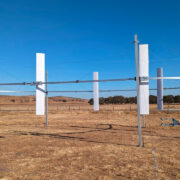3D printing rocket engines? It seems like these days you can 3D print just about anything. Just on this channel, we’ve talked about 3D printed next-gen perovskite solar panels, houses, and the development of advanced toroidal propellers for boats and drones. So you probably shouldn’t be surprised to learn that 3D printing is also making waves in rocket science. NASA has developed a revolutionary new rocket engine that’s 20-30% more efficient than anything else out there. Additive manufacturing techniques like 3D printing can make rockets quicker and cheaper, which could lead to better things for you and I down here on earth. But how?
Our phones help us stay in touch with our friends, check the weather, and help us find our way home. But it’s easy to forget that these features all rely on commercial satellites, and these commercial satellites only exist because NASA has passed their most successful tech on to businesses. Even though we’ve been doing it for years, putting something like a satellite in space is a costly, expensive and time consuming endeavor.
Rocket assemblies in particular contain some of the most expensive and physically demanding components of the whole craft — and for reasons we’ll dig into in a moment, additive manufacturing can speed up the process and make it cheaper.1 Perhaps most exciting of all, it’s allowing us to realize advanced designs that just weren’t feasible with older manufacturing techniques. How? I spoke to Paul Gradl, Principal Engineer at NASA, and a general 3D-printing-slash-additive-manufacturing enthusiast, and here’s what he had to say.
“But now that we can go build these complex passages, and we can use novel materials like GRCOP 42 and GRX 810, we have tested some rotating detonation rocket engines… Now with these engines, we get a 30% performance improvements. 20 to 30% over traditional engines, which is, you know, fantastic. Because I remember back in shuttle days, and some of the other development programs, we would chase after a half percent or 1% performance improvement, which was huge. And now you’re talking an order of magnitude more than that. So additive manufacturing is definitely changing the way that we can think about some of these advanced propulsion concepts, too.” -Paul Gradl
These numbers are truly impressive, but to understand exactly why these Rotating Detonation Rocket Engines, or RDREs, are such a big deal, let’s go into some further context. It takes incredible amounts of energy to get something into orbit, and every extra ounce requires extra propulsion. But fuel itself is very heavy. As a result, rockets have to be mostly fuel. The fuel alone accounts for 90 to 95% of a rocket’s weight.2 For comparison, just 4% of your car’s weight is fuel, and even top-of-the-line fighter jets are only about 30% fuel by weight.2 That’s why developing propulsion systems like RDRE’s is so important – they can save time and money by getting further with less fuel, with less weight, and … less money.
How much better are RDREs? A standard gas turbine engine has a thermodynamic efficiency of 36.9%, while an RDRE clocks in at almost double that with a thermodynamic efficiency of 59.3%.3 This is an astonishing improvement when you consider that for most of NASA history, efficiency jumps of 1% or less were cause for celebration.4 Furthermore, this design looks to be about 5% more fuel efficient than the standard. That might not sound like much, but remember how 90% or more of a rocket’s weight is fuel? On a Falcon rocket, a 5% fuel savings comes out to about 103 metric tonnes of go-juice. That’s a lot less weight to carry around, much less try to blast into space.5 How can an RDRE accomplish this? To understand how, we’ll have to put our PPE on and break down how NASA gets rockets off the ground.
Engines are driven by the burning of fuel to produce an expansion of gas. Even the six-cylinder engine in your car is powered by tiny but powerful gas expansions. A rocket engine is similar. During liftoff, an injector aerosolizes the fuel and a flame combusts it to generate thrust in a process called deflagration. But what if we could make this explosion better? What if we could…”RAMP” it up? Enter the RDRE, developed by NASA’s Rapid Analysis and Manufacturing Propulsion Technology division (or RAMPT, for short). In this design, the fuel-air mixture starts to deflagrate like normal, but then quickly detonates, producing shockwaves that travel around the inside wall of the device at 2,000 meters per second.
Eventually — and I say eventually, but the whole process takes microseconds — these waves establish a rotating shockwave moving in one direction that circles the chamber every 0.1 millisecond. The rotating wave slams into the next burst of air-and-fuel mixture entering the combustor, causing it to detonate, and the process repeats itself, generating more thrust more efficiently than a standard deflagration engine.4
But what does this have to do with 3D printing?
RDREs are looking more feasible every day thanks to the combo of freshly developed additive manufacturing techniques and new alloyed materials, like GRCOP42.
“We are able to make materials that didn’t exist prior to additive, and in some cases, they’re new families of materials, and some examples are GRCOP42. It’s a copper chrome niobium material that we use for high conductivity, high strength for rocket combustion chambers.” -Paul Gradl
The high strength is obviously desirable when you’re dealing with the massive ongoing explosions and shockwaves inside of RDREs, but the thermal conductivity is important, too. This ties in directly to additive manufacturing, so hang with me a second. Last gen rocket engine models can easily hit temperatures of 6,000 degrees Fahrenheit (or about 3,315 degrees Celsius).6 RDREs are even more extreme. The high temperatures would cause the rocket engines to melt, if they didn’t have adequate cooling.7 The high thermal conductivity of GRCOP42 allows the alloy to conduct heat away from the rocket, giving it a mechanism to cool down more quickly. However, heat still needs to be transferred away from the GRCOP42 into some other medium to prevent it from melting. . A popular technique, called regenerative cooling, performs the heat transfer allowing us to create a super heat tolerant rocket engine.8
While this sounds great, there’s a problem. Regenerative cooling works by pumping some of the super-cold rocket fuel through channels in the engine to keep everything cool, but machining all the intricate channels takes a lot of time and money. But 3D printing comes in handy here, too. By simply using CAD for the channels, the manufacturing process will print them fully integrated, saving time and money.9 10
The benefits of additive manufacturing extends to other parts of RAMPT’s RDRE as well. The shape of the engine is carefully printed to harness the power of detonation and help keep the shockwave pulse rotating. The tiny cooling valves are part of the additive manufacturing process too, along with the thrust chamber.1011
And while we’re still in the testing phase, the outlook is very positive. The RDRE prototype produced more than 4,000 pounds of thrust for nearly a minute. Pressure inside the engine also reached 622 pounds per square inch (PSI), which NASA says is the “highest pressure rating for this design on record.”12 That’s a specific record for this additive manufactured engine. There’s still a lot of room to go because the internal pressure of existing rocket engines ranges from 700 to 3,500 PSI.13
This is all very cool space-agey stuff, so much so that it can be hard to picture how it will benefit us back here on earth. I promise you, you’ll see the benefits sooner than you think, and you might be surprised at the ways NASA tech ends up in your home.
The first way these advances will impact us earthlings is through price. The unique, physically massive, and complex engineering of rocketry means before you can build a rocket to experiment with, let alone send into space, you first need to build the tools to build the rocket. This entails a lot of design iterations, prototyping, tons of testing, and expensive custom machining. It all adds up to create long waits between missions and high price tags.14
However, with additive manufacturing you can start by building the tools or the parts you need in CAD software and then print them. This can cut down on the time between tests, which reduces costs and also can really accelerate the speed of innovation. 3D printing can reduce weight by reducing complexity, which knocks down costs even further.14 15 Almost anything that currently requires a laborious hand-made process could benefit from additive manufacturing. Here’s Paul on the time and money-savings:
“Traditionally making the combustion chambers, right, took six months, twelve months in some cases, assuming that I could get my forgings and, you know, machining goes well and my brazing and welding and everything goes well on that. Well, with additive manufacturing… parts that were taking me months or years to make, I can make in days and months now. And with that comes huge cost savings, right? Because a lot of the parts we work with, aerospace, nothing is cheap…”
“Everything from our large components to the fasteners and seals that we use are all made to order. So some of these components can be hundreds of thousands of dollars, if not millions of dollars. So even if I get a… A few percent cost savings on it. That’s huge. With additive, there’s many cases where we see 50% or greater cost savings.” -Paul Gradl
By producing cheaper, more efficient rocket motors, the cost of satellite deployment is also reduced. This could well mean less expensive, more plentiful satellites and cheaper, easier access to everything they provide, from data collection and transmission, asset tracking, imaging, and more.
For example, satellite service Starlink is bringing the internet to places that have previously been unable to build out the necessary infrastructure to get online.16 With the UN deeming internet access a human right, more satellite internet providers are a net good.17 Your phone is another example of a technology that uses the services provided by commercial satellites. Who knows what new waves of innovation might stem from easier access to satellites?
But as amazing as additive manufacturing is, it isn’t a cure-all. Not everything can or should be fabricated with these techniques.
“There are certain challenges… you know. It’s easy to say, additive manufacturing. I’m hearing all this stuff about it, it’s a cool new kid on the block, I want to go use it for everything. Well, there’s still a lot of great manufacturing technologies, machining, that I can do much quicker for simpler parts and high production rates.” -Paul Gradl
There’s also a steep learning curve. If you’ve ever 3D printed something at home, you know how hard it can be to translate your ideas into CAD. With all the scaffolding and warping, there’s also a lot of trial and error. In our discussion, Paul noted that they have to deal with those same problems when working on rocket pieces. Even though CAD and additive manufacturing opens a lot of doors, there’s still some angles and shapes that just aren’t achievable with these tools…yet. And it can take a lot of time to train someone in CAD and get them caught with all the best practices, lest they make a costly mistake.
Additive manufacturing is the flashy new toy, and because of that it’s going to be misapplied to all sorts of things before it finds its niche. But all that said, it really does look like 3D printing is set to revolutionize rocketry and everything that relies on it. Best of all, NASA wants to spread the knowledge around.
“Another side of NASA too is, you know, not just being a player in the game. We’re also helping to be the commissioner of the team of sorts, right?.. We are setting some of the rules in industry in terms of standards and certification. So NASA has taken on a lot of roles as well in terms of certification. We’ve developed some very extensive documents for how to certify additively manufactured parts for human spaceflight.” -Paul Gradl
We mentioned Starlink, but NASA’s working with the California-based company Relativity Space to push rocketry even further with those new materials and 3D printing techniques. This March, the company launched a largely 3D printed rocket, which used 3D printed engines, thrusters and parts made from GRCOP42.1819 That partnership deserves its own video, so stay tuned. Similarly, NASA also passed the research baton off to a slew of partner universities like Cornell, Stanford, Texas A&M and more.20 The point is, NASA is an excellent springboard for innovation, alley-ooping research to lots of partners who can turn it into slam dunks.
And while you may never ride on a rocket with 3D printed parts, these breakthroughs should still excite you — because the technology NASA and their partners cook up for space exploration has a funny way of improving our lives back here on earth. The joystick on your Playstation controller, the filter in your water purifier, the insole of your running shoes, the camera in your cellphone and much, much more all come from NASA R&D.2122 Again, even if they never find earthly applications for this technology, it will still benefit us all. GPS, weather satellites, and the internet are all important things that we use every day. The first step is to develop the hardware that makes new ideas like these possible.
- Rapid Analysis and Manufacturing Propulsion Technology (RAMPT) ↩︎
- The Tyranny of the Rocket Equation ↩︎
- A Theoretical Review of Rotating Detonation Engines ↩︎
- Aerospace America – Increasing engine efficiency ↩︎
- How NASA Reinvented the Rocket Engine ↩︎
- Space Shuttle Engines: Just the Stats ↩︎
- Engine Cooling – Why Rocket Engines Don’t Melt ↩︎
- 3D-printed alloy 600 times as resistant to stress as existing alloys ↩︎
- Wiki – Regenerative Cooling (rocketry) ↩︎
- A Review Towards the Design Optimization of High Performance Additively Manufactured Rotating Detonation Rocket Engine Injectors ↩︎
- Current State of NASA Continuously Rotating Detonation Cycle Engine Development ↩︎
- Watch NASA Test a 3D-Printed Rocket Engine Made for Deep Space Travel ↩︎
- Spacecraft Materials ↩︎
- 3D-printed rocket engines: The technology driving the private sector space race ↩︎
- NASA Validates Revolutionary Propulsion Design for Deep Space Missions ↩︎
- The Role of Starlink in Empowering Developing Countries ↩︎
- Brookings Institute – The internet as a human right ↩︎
- 3D Printed Rocket Launched Using Innovative NASA Alloy ↩︎
- Relativity Space Terran 1 launched 3D printing parts in rocket science ↩︎
- NASA Strategic University Research Partnerships (SURP) ↩︎
- 10 everyday NASA inventions and spin-offs you can find in your home ↩︎
- 30 NASA inventions we still use everyday ↩︎
















Comments